Hi all,
This is my measurement of the popular eminence Alpha 15A. There are few caveats: the signal is already EQ'd (meaning the driver is being pushed more below its Fs) and measurement was taken in a small room. It's surprising that given the clean and deep output which OB bass can provide the measurement shows significant distortion at the extreme lows, even for a 15" driver.
What got me interested to do these measurement was when I feed 20Hz signal to my speakers, I can hear tones ! ... now that's not right as 20Hz shouldnt be audible
Hope you can add to this 'library' measurements of other popular woofers. We NEED clean bass - measured and listened
First test, 20Hz tone. 3rd order distortion dominates and this is not good as the ear gets more sensitive (fletcher-munson curve).
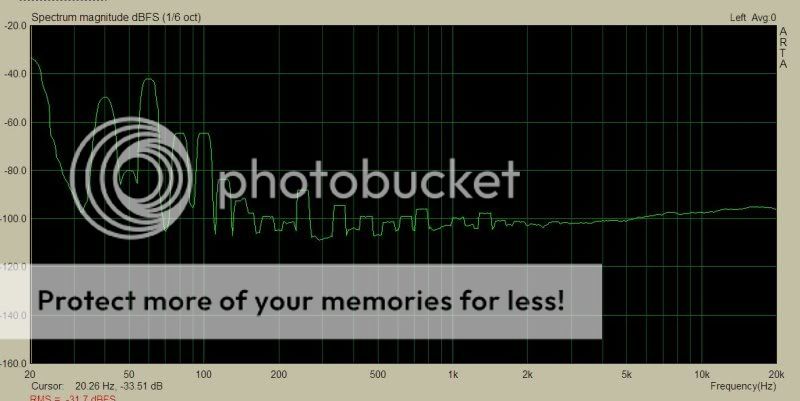
Second test, 30Hz. Signal to noise ration is significantly better and 2nd harmonics is equal with 3rd harmonics.
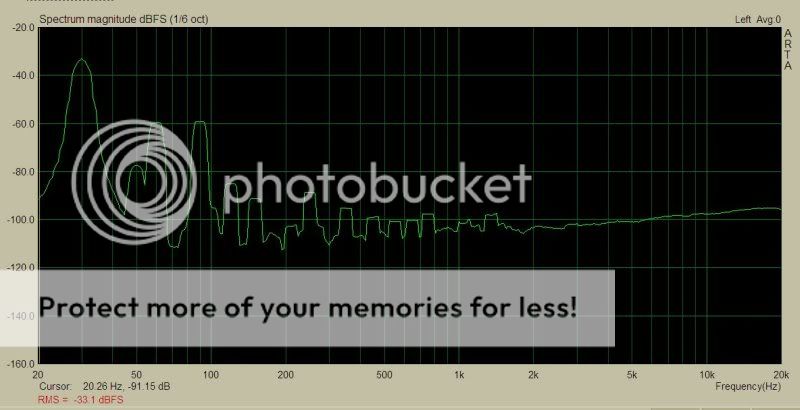
With 40Hz signal feed, the woofer seems to be performing very well. Note that Fs of the Eminence is 41Hz.
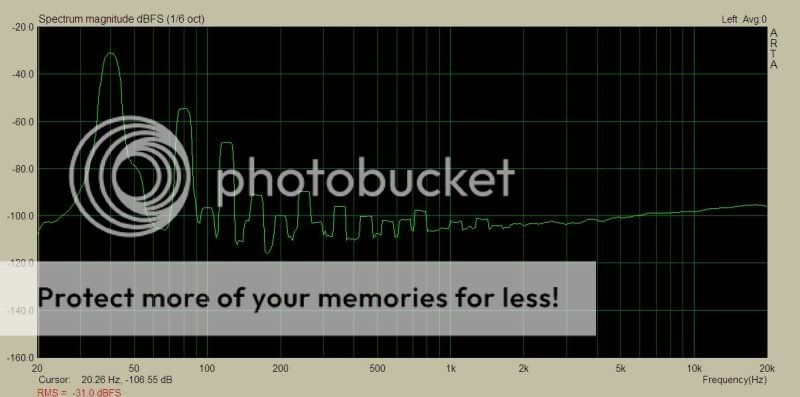
This is the overall plot.
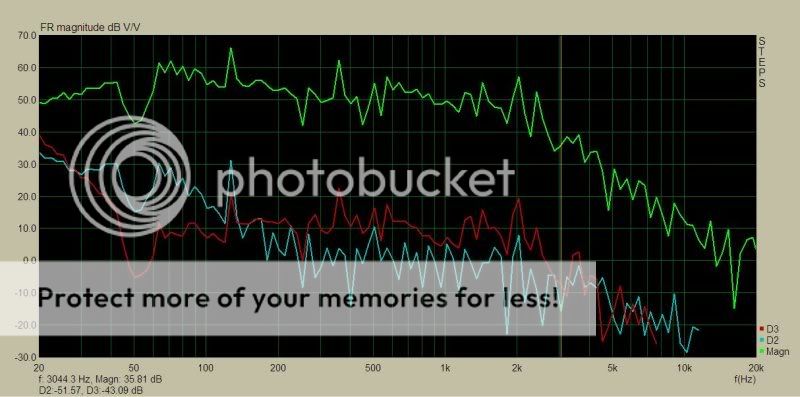
Learning how simple these measurement activity was, it makes me wonder why we rarely see nonlinear (and linear) distortion taken into design or review -- SL and Zaph being the few who emphasize them.
This is my measurement of the popular eminence Alpha 15A. There are few caveats: the signal is already EQ'd (meaning the driver is being pushed more below its Fs) and measurement was taken in a small room. It's surprising that given the clean and deep output which OB bass can provide the measurement shows significant distortion at the extreme lows, even for a 15" driver.
What got me interested to do these measurement was when I feed 20Hz signal to my speakers, I can hear tones ! ... now that's not right as 20Hz shouldnt be audible
Hope you can add to this 'library' measurements of other popular woofers. We NEED clean bass - measured and listened
First test, 20Hz tone. 3rd order distortion dominates and this is not good as the ear gets more sensitive (fletcher-munson curve).

Second test, 30Hz. Signal to noise ration is significantly better and 2nd harmonics is equal with 3rd harmonics.

With 40Hz signal feed, the woofer seems to be performing very well. Note that Fs of the Eminence is 41Hz.

This is the overall plot.

Learning how simple these measurement activity was, it makes me wonder why we rarely see nonlinear (and linear) distortion taken into design or review -- SL and Zaph being the few who emphasize them.
My position on this is that simply measuring the THD does not mean that its audible under real world signals or in real world conditions. In most of my work I find that the signal is measurably distorted, but its not audible.
To really discuss this topic however we would need to know some more specifics about the test conditions. This is nearfield? Whats the signal level? Whats the enclosure design?
To really discuss this topic however we would need to know some more specifics about the test conditions. This is nearfield? Whats the signal level? Whats the enclosure design?
Monte Kay has woofer distortion measurements on his site, with comments on applicability for dipole applications due to mechanical and aerodynamic noises.
http://www.mfk-projects.com/woofers.htm
http://www.mfk-projects.com/woofers.htm
gainphile said:What got me interested to do these measurement was when I feed 20Hz signal to my speakers, I can hear tones ! ... now that's not right as 20Hz shouldnt be audible
I've always noticed this as well, particularly with woofers at the lowest frequencies, just as you've realized. Whether they're in boxes or not, a 20 Hz sine wave often gives a strong 40 and/or 60 Hz tone. Not completely certain about high frequencies which Gedlee has experimented with, but at very low frequencies it's VERY audible. Isobaric configuration of woofers in enclosures supposedly helps this a bit.
gedlee said:Whats the enclosure design?
gainphile said:
Drew, thanks for that great link. I see similiarities between my measurements and his, so some things are right.
Earl, that was actually my experience. While had been listening for months with no complaint on LF distortion, this was an eye-opener as feeding 20Hz tone produced very audible 60Hz sound and was verified by the measurement. I suppose ear cannot discriminate absolute distortion but if theoretically we can have a 0 distortion speakers, I think these would stand out.
Imagine if manufacturers or reviewer include these data along with FR plot, it would be much easier to evaluate speakers, is it not?
Btw. the setup was nearfield measurement with OB setup, signal was equalised using SL shelving lowpass down to 11Hz. I may want to do measurements on unequalised signals later on.
Earl, that was actually my experience. While had been listening for months with no complaint on LF distortion, this was an eye-opener as feeding 20Hz tone produced very audible 60Hz sound and was verified by the measurement. I suppose ear cannot discriminate absolute distortion but if theoretically we can have a 0 distortion speakers, I think these would stand out.
Imagine if manufacturers or reviewer include these data along with FR plot, it would be much easier to evaluate speakers, is it not?
Btw. the setup was nearfield measurement with OB setup, signal was equalised using SL shelving lowpass down to 11Hz. I may want to do measurements on unequalised signals later on.
gainphile said:Earl, ... but if theoretically we can have a 0 distortion speakers, I think these would stand out.
Imagine if manufacturers or reviewer include these data along with FR plot, it would be much easier to evaluate speakers, is it not?
I think that its not time well spent running after things that don't make any difference, like THD in woofers.
But to get into more detail its critical to next consider the bandwidth that the woofer will have because the greater the bandwidth the more audible the nonlinearity will be. An OB with EQ is a worst case scenario for LF distortion and I would definately NOT take a woofer in that configuration up very high in frequency.
A bandpass design, on the other hand, will have the harmonics acoustically LP filtered and the bandwidth is minimal so nonlinearity is not ever a factor. Its all about the system design as to whether or not these things are a problem.
gainphile, thanks for doing that - I am planning on doing just the same with my Alpha 15s in H frames soon. Your measurements look about right to me. I would expect a lot of distortion from this driver. But in my system, it sounds pretty good, even considering our ears increased sensitivity to the higher harmonics. I'm a fan of Monte Kay's site, he has the only set of woofer distortion measurements I know about. I'm hoping to build another set of H frames soon, using the RSS315 he suggests.
Moondog55 said:I can't hear anything that low
Maybe, but you can certainly FEEL it by your whole body. That's also count in 'audio' experiences. For some, it's rather important.
Moondog55 said:OH!! I do like that feeling of having my "Liver quiver"
m\My comment was directed more at my ability to hear anything distorting or being able to hear any overtones
20Hz and below shouldn't be audible, and to hear the distortion is actually quite simple. Download ARTA and run a 20Hz test tone. You shouldnt hear anything (but you will, those 40 and 60hz tones unfortunately) Of course you can drop by if happen to be in Chelsea area. I can give you a panasonic mic freebie its very linear, only need a capacitor and 9v battery to make it work
On the subject of very low frequency, I have experimented blocking subsonic information using HP filter at 20Hz. Mainly due to my vinyl rips which contains many 10-hz rumble and cause excessive cone movements. What I found out was the overall sound/feel changed. Not as full/weight-y as before. I ended up removing the HPF and just listen to lower level on some recordings.
This is an FFT of "normal" of CD recording
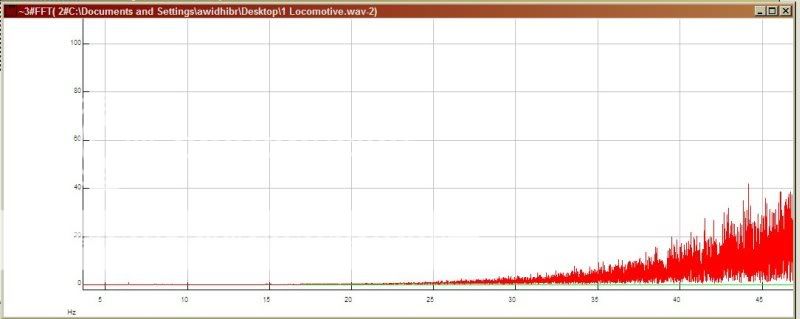
Compare with this Vinyl rip
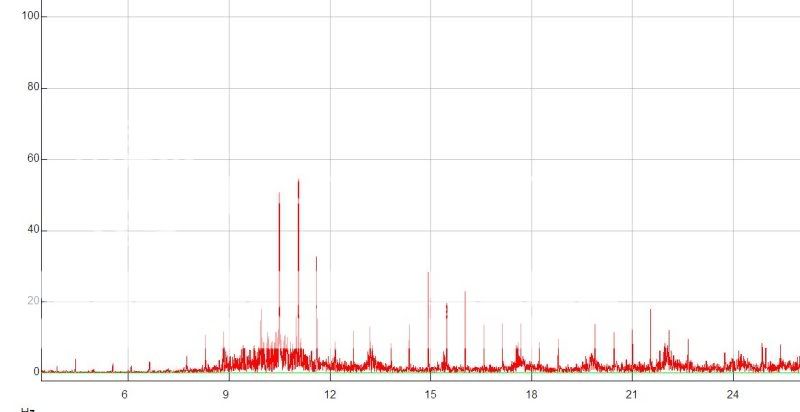
Some recording are so bad, containing many spectral information below 20Hz. This is Jeena Lodwick "Do it to me one more time"
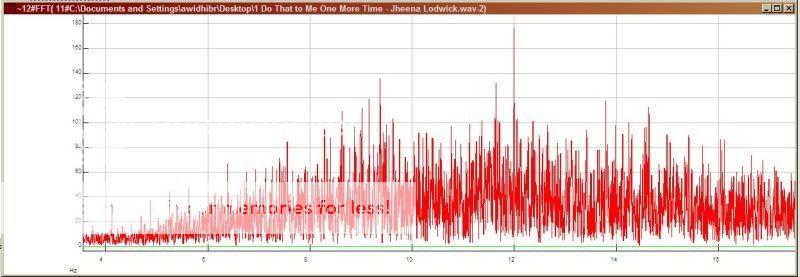
gedlee said:
I think that its not time well spent running after things that don't make any difference, like THD in woofers.
Don't forget about localization.
gainphile said:20Hz and below shouldn't be audible, and to hear the distortion is actually quite simple. Download ARTA and run a 20Hz test tone. You shouldnt hear anything (but you will, those 40 and 60hz tones unfortunately) Of course you can drop by if happen to be in Chelsea area. I can give you a panasonic mic freebie its very linear, only need a capacitor and 9v battery to make it work
With my sealed bass boxes, I can run the ol' Stereophile "shake rattle and roll" track from one of their CDs and 20Hz is audible. Not as loud as 30Hz, but still hearable. And, no, I'm not mistaking a harmonic for the primary tone like a lot of people I've met - who think they've got a 25Hz speaker when all they are hearing is the string strike and they're imagining the rest ("it's so tight"). I've also got some test tones from 5Hz up to 30Hz, and the bass boxes I've start producing audible bass from maybe 17Hz (might be 18, I can't remember).
I can try to run them harder, but they start to get a little bit wheezy, as I only ever intended them to run down to about 35 - but the room that I'm currently in is very small, and for most music (and HT for that matter) it's fine. If I'm ever allowed to use a bigger room, then I'll have to build my subwoofer...

gedlee said:My position on this is that simply measuring the THD does not mean that its audible under real world signals or in real world conditions.
My position is that it *is* audible, especially with electronic music, and can be such that the harmonic distortion from very low bass masks/interferes with mid bass.
I would also suggest that the higher the Qes the higher the potential for distortion.
I have run a Beyma SM-115N in parallel with an Eminence DeltaPro-18A at 20 Hz.
The Beyma was audible - the Eminence not - even though both were displacing considerable volumes of air !
They both produce reasonable LF on OB, but the Beyma is notably less articulate than the Eminence.
On the other hand the Eminence does not sound as loud as the Beyma (less distortion).
In parallel together on the same OB they work very well; each partially compensating for the weaknesses of the other, and with a reproduction quality that neither alone can achieve !
Cheers ......... Graham.
454Casull said:
Don't forget about localization.
This is a good point. While I don't believe that THD affects the tonal quality of LF at all, I have seen situations where the higher harmonics allow one to localize the subs, which is a bad thing. With a bandpass design this is again not an issue.
Quote from GedLee:
"A bandpass design, on the other hand, will have the harmonics acoustically LP filtered and the bandwidth is minimal so nonlinearity is not ever a factor. Its all about the system design as to whether or not these things are a problem."
Good point. This might be the best argument I've ever heard for using a bandpass box. Has me thinking. Thanks.
I only wish I'd have heard a bandpass box that doesn't huff, chuff, muddle, and one note the bass to objectional oblivian. I'll start searching. Anyone have a link to a great bandpass design?
Thanks,
Dan
"A bandpass design, on the other hand, will have the harmonics acoustically LP filtered and the bandwidth is minimal so nonlinearity is not ever a factor. Its all about the system design as to whether or not these things are a problem."
Good point. This might be the best argument I've ever heard for using a bandpass box. Has me thinking. Thanks.
I only wish I'd have heard a bandpass box that doesn't huff, chuff, muddle, and one note the bass to objectional oblivian. I'll start searching. Anyone have a link to a great bandpass design?
Thanks,
Dan
dantheman said:I only wish I'd have heard a bandpass box that doesn't huff, chuff, muddle, and one note the bass to objectional oblivian. I'll start searching. Anyone have a link to a great bandpass design?
Bad noises are a function of port size. You need to use a decent sized port. And the "one note" problem only indicates to me that the designer didn't know what he was doing. I can get bandpasses to go almost two octave - lower efficiency of course.
Its not "a" design, its a whole design approach. I've done dozens of bandpass boxes, they all work fine. Someday, I'll share some designs but for now its just too much trouble drawing it up in a usable form. The approach is simple. There are lots of software packages that can do it.
As to the "transients", well this is not really a very good question. I'm not saying that its dumb or anything - I get it a lot - its just that it has no meaning. Bandpass boxes are subs, LFs only. Transients are HFs. The rate of rise of a transient is directly proportional to the bandwidth of the system and its HF capability. Since subs don't have any high frequency response (deliberately) and they have very small bandwidth one has to expect that the transient response will be, well, slow. "Fast bass" is simply not a valid concept. Fast and bass are distinct opposites.
As to the "transients", well this is not really a very good question. I'm not saying that its dumb or anything - I get it a lot - its just that it has no meaning. Bandpass boxes are subs, LFs only. Transients are HFs. The rate of rise of a transient is directly proportional to the bandwidth of the system and its HF capability. Since subs don't have any high frequency response (deliberately) and they have very small bandwidth one has to expect that the transient response will be, well, slow. "Fast bass" is simply not a valid concept. Fast and bass are distinct opposites.
- Status
- This old topic is closed. If you want to reopen this topic, contact a moderator using the "Report Post" button.
- Home
- Loudspeakers
- Multi-Way
- Dipole woofer nonlinear distortion
